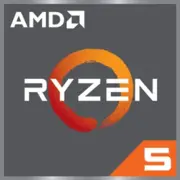AMD Ryzen 5 1600X

AMD Ryzen 5 1600X in 2025: Is it worth getting the legendary hexa-core processor?
An updated look at the processor that changed the PC market
Key Specifications: Old Hardware with Relevant Potential
The AMD Ryzen 5 1600X processor, released in 2017, became a symbol of AMD's "renaissance" in the battle against Intel. Despite its age, in 2025, it remains popular in budget builds due to its successful combination of characteristics:
- Zen Architecture (1st Generation): 6 cores and 12 threads—a revolution for the mid-range market at the time.
- 14nm process technology by GlobalFoundries: Not the most energy-efficient by modern standards, but stable.
- Base/Turbo Frequency: 3.6 / 4.0 GHz. With overclocking (if you're lucky with your chip), you can squeeze up to 4.1–4.2 GHz.
- L3 Cache 16 MB: Sufficient for gaming and uncomplicated work tasks.
- TDP 95W: Requires good cooling, but it’s not critical.
- Geekbench 6 (2025): 1127 (single-threaded), 4764 (multi-threaded). By comparison: Ryzen 5 5500 scores around ~1600/6000.
Key Features:
- Multi-threading support in the budget segment.
- Unlocked multiplier for overclocking.
- Compatibility with the still-relevant AM4 platform.
Compatible Motherboards: How to Choose Wisely
Ryzen 5 1600X uses the AM4 socket, but not all chipsets support it "out of the box":
- Recommended Chipsets:
- B350/X370 (2017): An ideal choice, but new boards are rare. Prices for leftovers are $60–90.
- A320 (cheaper option): Support is there, but no overclocking.
- B450/X470: Require BIOS updates. For example, the MSI B450 Tomahawk Max ($80–100) is a proven option.
Caution! B550/X570 chipsets do not support Ryzen 1000/2000 series.
User Experience:
A user purchased an ASRock B450 Steel Legend, updated the BIOS via USB Flashback, and ran the Ryzen 5 1600X without any issues.
Memory: Only DDR4, but with nuances
- Type: DDR4 (DDR5 is not supported).
- Frequencies: Officially up to 2666 MHz, but on many boards, it works with 2933–3200 MHz (depends on the memory chip and motherboard).
- Recommendations:
- Optimal: 2x8 GB DDR4-3000/3200 (for example, Corsair Vengeance LPX).
- Avoid quad-channel kits—a Ryzen 5 1600X works better with a dual-channel configuration.
Real Case:
A build with Kingston HyperX Fury 3200 MHz (overclocked to 2933 MHz) provided an 8–12% performance boost in games compared to 2400 MHz.
Power Supply: Calculated for Upgrade
- Power: Minimum 450W (for example, EVGA 450 BR).
- Recommendations:
- For systems with a GPU like the RTX 3060 or RX 6600—550–650W (Corsair CX650M).
- Choose units with an 80+ Bronze certification or higher.
Important! Ryzen 5 1600X does not include a cooler. Add $20–30 for a tower cooler (Deepcool Gammaxx 400).
Pros and Cons in 2025
Pros:
- Price: $80–120 for new (rare leftovers) or $40–60 used.
- Multi-threading for rendering and streaming.
- Easy upgrade to Ryzen 5000 on AM4.
Cons:
- No PCIe 4.0—limitation for modern SSDs and GPUs.
- High power consumption compared to Ryzen 5 5500 (65W).
- Weak single-threaded scores—loses out in games to newer CPUs.
Use Cases: Where the 1600X Still Holds Its Ground
1. Gaming on Medium Settings:
- In conjunction with a GPU like the GTX 1660 Super or RX 6600—60 FPS in Full HD (Cyberpunk 2077 on medium).
- Drawback: Drops to 45 FPS in CPU-intensive scenes (e.g., Assassin’s Creed Valhalla).
2. Work Tasks:
- Video editing in Premiere Pro (1080p), 3D modeling in Blender.
- Not for professionals: rendering a 10-minute video will take 25–30 minutes compared to 15 minutes with Ryzen 5 7600.
3. Home PC/Multimedia:
- Streaming in 1080p (OBS + NVENC).
- Retro console emulators (up to PS2 inclusive).
Comparison with Competitors
- Intel Core i5-7600K (4 cores/4 threads):
- In 2025, it definitely lags in multi-threading (4764 vs 2400 in Geekbench 6 Multi).
- Used Price: $50–70.
- Ryzen 5 5500 (2022):
- Newer, 30–40% faster, but more expensive ($130–150 new).
- A better choice if the budget allows.
Conclusion: The Ryzen 5 1600X outperforms older Intel CPUs but falls short against modern budget options.
Practical Assembly Tips
1. Motherboard: Look for B450 with guaranteed Zen 1 support (e.g., Gigabyte B450 Aorus Elite).
2. RAM: 16 GB DDR4-3000 is the minimum. 32 GB is ideal for work tasks.
3. Cooling: Even a budget Deepcool AG400 will suffice.
4. Graphics Card: Don't go higher than RTX 3060/RX 6600 XT—the processor will become a "bottleneck" in AAA games.
5. SSD: Choose NVMe with PCIe 3.0 (e.g., WD Blue SN570).
Example Build for $400:
- CPU: Ryzen 5 1600X ($80 new).
- Motherboard: ASRock B450M Pro4 ($70).
- RAM: TeamGroup Vulcan 16 GB DDR4-3200 ($45).
- Graphics Card: RX 6600 (used, $150).
Final Verdict: Who Should Consider the Ryzen 5 1600X in 2025?
This processor is worth considering in three scenarios:
1. Upgrading an Old AM4 PC: If you have a B350/X370 board and no budget for the Ryzen 5 5600.
2. Minimum Investment Build: For studying, office work, indie gaming.
3. Retro Enthusiasts: Hobbyists experimenting with 2010s hardware.
Alternative: If you're willing to add $50–70, the Ryzen 5 5500 or Intel i3-12100F will deliver significantly better results. But for those seeking a cost-effective "workhorse," the 1600X is still viable!
Prices are current as of April 2025. Information is based on data from open sources and the experiences of enthusiasts.
Basic
CPU Specifications
Memory Specifications
GPU Specifications
Miscellaneous
Benchmarks
Compared to Other CPU
Share in social media
Or Link To Us
<a href="https://cputronic.com/index.php/cpu/amd-ryzen-5-1600x" target="_blank">AMD Ryzen 5 1600X</a>